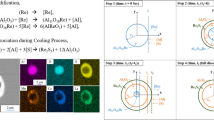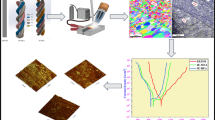The effect of prolonged heat treatment (single- and two-stage firing in a tunnel kiln) of specimens based on HCBS in the Al2O3–SiO2 –SiC system on their indices is studied. Specimens containing 15% SiC and 1 and 2% Si are characterized by a significant increase (up to 9%) in porosity and a reduction in strength compared with original specimens (without SiC) after prolonged heat treatment (120 hours in the range 1300 – 1400°C). significant increase in specimen volume is due not only to oxidation of SiC or Si, but also due to additional mullite formation. It is assumed that subsequently during oxidation of SiC at a certain stage of heat treatment there is mullitization due to the interaction of newly formed SiO2 in the form of cristobalite with bauxite Al2O3.






Similar content being viewed by others
References
P. V. Dyakin, Yu. E. Pivinskii, and A. Yu. Kolobov, “Research in the field of composite materials based on HCBS and refractory materials based on the system Al2O3–SiO2–SiC. Part 3,” Novye Ogneupory, No. 9, 14 – 22 (2018).
Yu. E. Pivinskii and P. V. Dyakin, “Research in the field of composite materials based on HCBS and refractory materials based on the system Al2O3–SiO2–SiC. Part 2,” Refract. Ind. Ceram., 59(3), 247 – 251 (2018).
Yu. E. Pivinskii and P. V. Dyakin, “ Research in the field of composite materials based on HCBS and refractory materials based on the system Al2O3–SiO2–SiC. Part,” Refract. Ind. Ceram., 59(2), 124 – 133 (2018).
I. D. Kashcheev, K. K. Strelov, and P. S. Mamykin, Refractory Chemical Technology [in Russian], Intermet Inzhiniring, Moscow (2007).
G. G. Gnesin, Silicon Carbide Materials [in Russian], Metallurgiys, Moscow (1977).
I. S. Kainarskii and É. V. Degtyareva, Carborundum Refractories [in Russian], Metallurgiya, Khar’kov (1963).
A. P. Luz, M. A. J. Braulio, and V. C. Pandolfelli, Refractory Castable Engineering, Goller Verlag GmbH, Baden-Baden, Germany (2015).
Ren Bo, Sang Shaobai, Li Yawei, and Xu Yibiao, “Effects of oxidation of SiC aggregates on the microstructure and properties of bauxite – SiC composite refractories,” Ceram. Int., 41, 2892 – 2899 (2015).
J. Roy, S. Chandra, S. Das, and S. Maitra, “Oxidation behavior of silicon carbide — a review,” Rev. Adv. Mater. Sci., 38, 29 – 39 (2014).
S. A. Zaida and H. H. Jasim Zaidan, “Effect nano-SiC additives in physical and mechanical properties of bauxite refractories used in oil units,” Eng. Technol. J., 35, Part A, No. 10, 992 – 998 (2017).
Yu. E. Pivinskii, P. V. Dyakin, and L. V. Ostryakov, “Research in the field of preparing molded and unmolded refractories based on high-alumina HCBS. Part 14. Composition and some properties of composite composition ceramic concretes in the system Al2O3–SiO2–SiC–C,” Refract. Ind. Ceram., 59(1), 53 – 70 (2018).
E. M. Grishpun, Yu. E. Pivinskiy, E. V. Rozhkov, et al., “Production and service of high alumina ceramic castables. 1. Ramming mixtures based on modified bauxite HCBS,” Refract. Ind. Ceram., 41(5), 104 – 108 (2000).
E. V. Rozhkov, Yu. E. Pivinskii, M. Z. Naginskii, et al., “Production and service of high alumina castables. 2. Properties and service of vibration placed castables based on bauxite-modified highly concentrated ceramic binding suspensions (HCBS) for use in blast-furnace runners,” Refract. Ind. Ceram., 42(5/6), 209 – 215 (2001).
Lida Masakszu, Eizo Maeda, and Tsuyoshi Okamoto, “Effect of SiC oxidation on corrosion resistance of castable for metal line of blast furnace main trough,” Taikabutsu Overseas, 27(2), 90 – 95 (2007).
V. A. Perepelitsyn, L. V. Ostryakov, M. N. Dunaeva, and A. Yu Kolobov, “Phase transformations of concrete of the Al2O3–SiC–C system during slag resistance testing,” Refract. Ind. Ceram., 59(4), 350 – 358 (2018).
ZhangWei, DayWenyong, and Nobuaki Chiyoda, “Research on thermal shock resistance of mullite – bauxite – silicon carbide refractory,” Chin. J. Geochem., 31, 204 – 208 (2012).
Yu. E. Pivinskii and P. V. Dyakin, “Research in the field of preparing molded and unmolded refractories based on high-alumina HCBS. Part 4. Effect of refractory clay addition on properties of compound composition HCBS, castings and materials based on them,” Refract. Ind. Ceram., 57(1), 70 – 76 (2016).
Yu. E. Pivinskii, P. V. Dyakin, and L. V. Ostraykov, “Research in the Field of preparing molded and unmolded refractories based on high alumina HCBS. Part 5. Effect of firing temperature on properties of materials prepared from composite HCBS with addition of refractory clay,” Refract. Ind. Ceram., 57(2), 180 – 184 (2016).
Yu. E. Pivinskii, V. A. Perepelitsyn, P. V. Dyakin, et al., “Research in the field of preparing molded and unmolded refractories based on high-alumina HCBS. Part 13. Effect of firing temperature on phase composition, structure, and some properties of materials based on composite composition HCBS (bauxite, electrocorundum, quartz glass),” Refract. Ind. Ceram., 58(6), 652 – 659 (2018).
Author information
Authors and Affiliations
Corresponding author
Additional information
1Continuation. Parts 1, 2, and 3 of article published in Novye Ogneupory, Nos. 3, 5, and 9 (2018).
Translated from Novye Ogneupory, No. 3, pp. 21 – 27, March, 2019.
Rights and permissions
About this article
Cite this article
Pivinskii, Y.E., Dyakin, P.V. Research in the Field of Composite Materials Based on HCBS and Refractory Materials Based on the System Al2O3–SiO2–SiC. Part 41. Refract Ind Ceram 60, 142–148 (2019). https://doi.org/10.1007/s11148-019-00325-x
Received:
Published:
Issue Date:
DOI: https://doi.org/10.1007/s11148-019-00325-x




